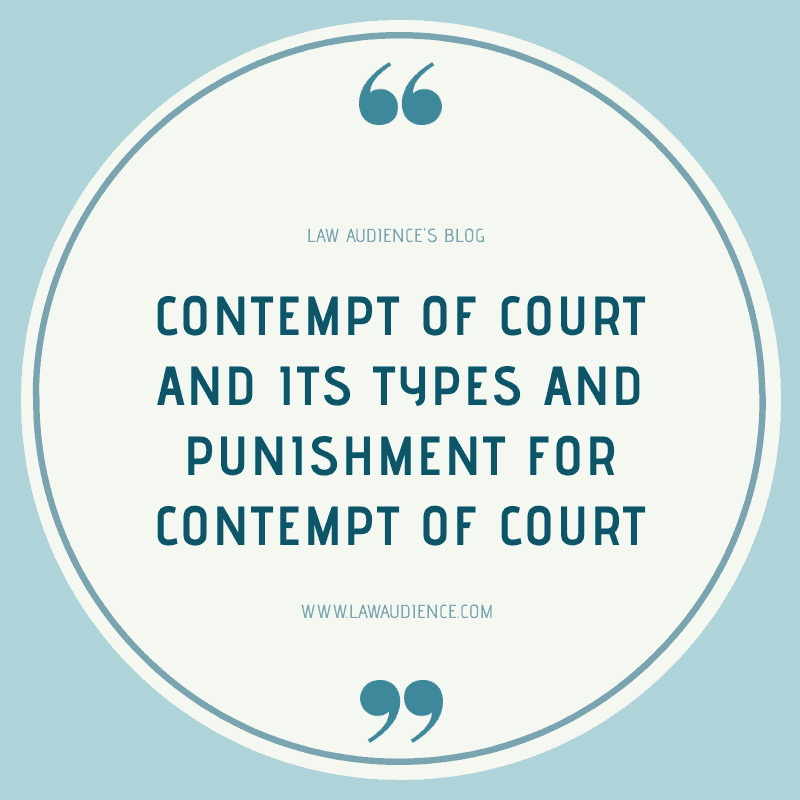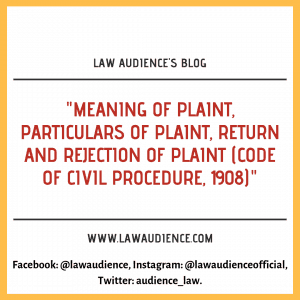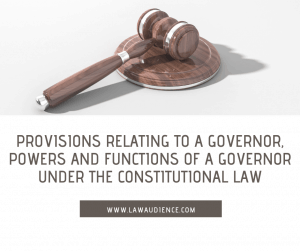AUTHORED BY: MS. NISHITA KAPOOR, B.COM.LL.B, STUDENT AT UNIVERSITY INSTITUTE OF LEGAL STUDIES, PANJAB UNIVERSITY & RESEARCH WRITER AT LAW AUDIENCE.
I. WHAT IS CONTEMPT OF COURT:
It is a creature of Common Law and is an offence sui generis.[1]Contempt is such conduct of a person which is likely to prejudice the fair trial or cause interference in the exercise of judicial power. It helps to maintain law and order and aims at protecting the authority of the Judiciary. It has been defined for the first time by The Contempt of Courts Act, 1971. Essentially the definition under the Act is more of a classification of the term “Contempt of Court” as it has been defined as “means Civil Contempt or Criminal Contempt.”
II. TYPES OF CONTEMPT OF COURT:
The object of every type of Contempt of Court is to ensure that the administration of the justice is upheld. The Contempt of court has been classified under following two heads under The Contempt of Court Act, 1971:
- Civil Contempt
- Criminal Contempt.
a) CIVIL CONTEMPT:
It has been defined under the Act as “willful disobedience to any judgement, decree, order or other processes of a court or willful breach of an undertaking given to a court.”[2] The term ‘willful’ means doing an act voluntarily which is forbidden by the law or omission to do something which law requires a person to do.[3] Its purpose is to compel a party to obey the order or decree of the court which is made against him. It is essentially of private nature and it is for the benefit of the party in whose favour the order is passed.
Some of the instances of Civil Contempt are:
- When a person gives an undertaking to the court then he is bound to comply with it. If he breaks it then he will be liable for the Civil Contempt. (Balasubramaniyam v. P. Janakaraju & others[4]).
- An officer who refuses to serve the summons upon his subordinate commits civil contempt unless it is due to non-availability of such subordinate.(Brijvallaha v. A. Q. Khanam[5]).
- An injunction granted against Municipal Corporation is binding on all its officers and if such officers disobey it even though they were not parties to the suit, they will be liable for the contempt.(Santosh Kionar Sannat v. Raja Shir Birachandra Jadumani Deo[6]).
- When a police officer disobeyed the bail order and did not release the arrested person despite the bail order being produced before him was held liable for civil contempt.(Bijay kumar Mohanty v. Jadu alias Ram Chandra Sahoo[7]).
- Where a person gives an undertaking to the court on the basis of certain assumptions which are false according to his knowledge, he will be guilty of misconduct amounting to contempt.(Bhatnagar & Co. v. Union of India[8]).
b) CRIMINAL CONTEMPT:
It has been defined under the Act as “the publication (whether by words, spoken or written, or by signs, or by visible representation, or otherwise) of any matter or the doing of any other act whatsoever which:
- Scandalizes or tends to scandalize, or lowers or tends to lower the authority of, any court;
- Prejudices, or interferes or tends to interfere with, the due course of any judicial proceeding; or
- Interferes or tends to interfere with, or obstructs or tends to obstruct, the administration of justice in any other manner”[9]
1. SCANDALIZING THE AUTHORITY OF COURT:
This concept of scandalizing has been borrowed from the English Law. Any act or publication by which the authority of the court is lowered constitutes Criminal Contempt. The rationale of this offence has been laid down in the Re Arundati Roy[10], as “To restore the confidence of people in Independence of Judiciary and such confidence cannot be allowed to be tarnished or wiped out by the behaviour of any person.”
This covers the publications made against the act done by the “Judge as a Judge” and does not cover the averments made against the private acts of a judge, which are outside the scope of his duty. The main objective is to protect and uphold the authority of the court. Any publication which deters the prospective litigants from relying upon the administration of justice by the court or creates an apprehension in the minds of the public about the ability or fairness of a judge constitutes the offence of criminal contempt by scandalizing the authority of the court.[11]
2. INTERFERENCE WITH THE COURSE OF JUDICIAL PROCEEDINGS:
This provision is based on the principle that “Every accused has a right to fair trial”. There are multiple ways by which there could be interference in a fair trial and media trial is one such way. It is not necessary that there is actual interference with the course of judicial proceeding but any act which likely to interfere with it also constitutes criminal contempt.[12]
3. INTERFERENCE WITH THE ADMINISTRATION OF JUSTICE:
For the administration of justice it should be ensured that the public has unhindered access to the courts for the determination of disputes relating to their rights and liabilities and once such dispute is submitted to the court, they should be able to rely upon the courts there is no interference of any other person.
Instances of interference with the administration of justice:
- A person who causes a disturbance in the court by talking loudly in the court and defies the authority of police who asked him to remain silent on court’s order amounts to interference with the administration of justice.[13]
- A tenant repeatedly gave false affidavit before the Court that he had vacated the premises which he in actual had not. His conduct was held to be impeding the administration of justice and hence constituted criminal contempt.[14]
III. PUNISHMENT FOR CONTEMPT OF COURT:
The power to punish is vested in the judges not merely for their personal protection but for the protection of public justice.[15] The punishment for contempt of court as prescribed under Section 12 of The Contempt of Courts Act, 1971 is of simple imprisonment which may extend to a term of six months or with fine extending to rupees two thousand or both. For Civil Contempt, if the court considers that only imposing fine would not serve the purpose then the contemnor in such a case can be detained in a civil prison for a period not exceeding six months.
The contemnor may be discharged or his punishment can be remitted by making an apology to the court. It is entirely in the discretion of the court to accept such an apology. In the case of Vishram Singh Raghubanshi v. State of Uttar Pradesh[16], the court held that the contemnor was not even sure that he committed contempt or not and he gave his apology after he realized that he would be punished. So the court considered such an apology was not sincere and hence he was held liable for imprisonment.
[1] Sahara India v. SEBI, AIR 2012 SC 3829.
[2] Sec. 2(b) of The Contempt of Courts Act,1971.
[3] Ashok Paper Kamgar Union v. Dharam Godha, AIR 2004 SC 105.
[4] 2004(5) Kar. LJ 338.
[5] AIR 1958 Raj 293.
[6] AIR 1965 Ori 222(224).
[7] (2003) 1 SCC 644.
[8] AIR 1957 SC 478.
[9] Section 2(c) of The Contempt of Courts Act,1971.
[10] Contempt petition (Cr) 10 of 2001.
[11] Brahma Prakash Sharma v. State of Uttar Pradesh,1953 SCR 1169.
[12] Hira Lal Dixit v. State of Uttar Pradesh, AIR 1954 SC 743.
[13] State v. Sunderlal, 1963 (2) CrLJ 62 (63) All.
[14] Rity Markandey v. Surjit Singh Arora, AIR 1997 SC 2174.
[15] Delhi Judicial Service Association v. State of Gujarat, AIR 1991 SC 2176.
[16]Criminal Appeal No. 697 of 2006.



